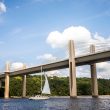Eight ways to better manage the water rules
The Long Term 2 Enhanced Surface Water Treatment Rule (LT2) will require all surface water systems to monitor for the waterborne protozoan Cryptosporidium for at least 24 months. Those with source water concentrations above certain limits will require additional levels of treatment. For many utilities, the combination of meeting higher levels of treatment for Cryptosporidium and more stringent disinfection byproduct limits will require new technologies and processes.
The following tips should be helpful to utilities just starting the process, and are based on the results of LT2’s required two years of source water monitoring for 32 water systems:
-
Plan early. Both rules have numerous deadlines for submitting sampling plans, reporting results and meeting maximum contaminant limits (MCLs).
-
Consider the timing of sample collection, analysis and work load on staff members. Even if the lab analyses will be contracted, a substantial amount of training and planning needs to be done.
-
Contact testing laboratories now, even if testing is not required for another 12 to 18 months. As of May 2006, 42 laboratories were approved by the EPA for Cryptosporidium analysis. (See http://www.epa.gov/safewater/disinfection/lt2/lab_aprvlabs.html) However, 16 of the labs are not accepting outside samples, while three are accepting limited samples.
-
Carefully examine the credentials and capability of the testing laboratories to make sure they are not over committed. Cryptosporidium testing requires careful analysis, and the quality of the testing may be reduced if the workload is too high.
-
Do not necessarily take the lowest bid for analysis. It is better to pay for quality work than to have bad data, which could cost millions of dollars in unnecessary treatment upgrades.
-
In collaboration with the laboratory, carefully develop a sampling schedule. The LT2 rule requires samples to be collected within two days (before or after) of the scheduled time. Consider vacations, holidays and contingencies for both the utility and lab staff.
-
Besides Cryptosporidium testing, the LT2 rule will require source water E. coli and turbidity testing. Although labs certified for potable water coliform testing will be approved for raw water E. coli analysis, the types of samples will be different.
-
Conduct one to two practice runs to work through the details.
Based on the results of the 32 sites, designs for plant upgrades — including the use of ultraviolet treatment — are already under way for several of the systems. Using the preparations helps manage costs and accurately forecast capital projects. Proper planning will result in good lab results, and will help utilities manage and protect the safety of drinking water.
Mark LeChevallier is director of innovation and environmental stewardship for Voorhees, N.J.-based American Water.




















